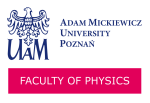Exploiting resonance effects in ferromagnetic nanoresonators towards magnonic spacetime metasurfaces
Polish title: Wykorzystanie efektów rezonansowych w ferromagnetycznych nanorezonatorach, w kierunku otrzymania magnonicznych metapowierzchni czasoprzestrzennych
Grant
National Science Centre, Poland call PRELUDIUM-21
Project no. 2022/45/N/ST3/01844
Starting date: 15 II 2023
Finish date: 14 II 2026
Team
Principal Investigator (PI)mgr Krzysztof Sobucki >>>
Supervisor
prof. dr hab. Maciej Krawczyk >>>
Project description
Spin wave (SW) is a propagating disturbance of magnetization in a medium, the quantum of which is called a magnon. Magnonic devices, i.e., devices utilizing SWs, are believed to be suitable to support or even replace currently used electronic devices for signal processing. This is due to the properties of SWs, which require much lower energies to transmit information since they are characterized by chargeless and massless propagation. For these reasons, magnonic devices are expected to have low energy consumption and do not suffer from Joule heating, which dramatically limits the possibilities of electronic devices. However, the design of magnonic devices demands, among other things, proper control over SWs phase, amplitude, and direction of propagation in a manner that is suitable for fabrication and operation. In this project, we will address theoretically new methods for controlling SW propagation that can be used in the design of new types of magnonic devices. In our research we will develop the concept of a magnonic Gires-Tournois interferometer (GTI) consisting of a narrow resonator placed over the edge of a magnetic film. Finally, we will attempt to create a magnonic spacetime metasurface (MSTMS) by applying a spacetime periodic magnetic texture to GTI resonator, and we will investigate MSTMS influence on propagating SWs in a ferromagnetic film. In the first part of our project, we will investigate the properties of the modes hosted by GTI, especially looking for so-called leaky modes that emit their energy back to the system. Then, we will study the possibility of exciting such modes with SWs incident on GTI. The second part of the project will be devoted to inelastic scattering processes in a uniformly magnetized system. The main objective of this part will be to find conditions for efficient stimulated splitting (creation of SWs with decreased frequency) and confluence process (SWs with increased frequency) during SWs scattering on modes localized in GTI. In addition, a possible spatial shift along the interface of the scattered SWs will be investigated, which would be an analogue to the Goos-Hänchen effect known in optics, which manifests as a spatial shift of reflected waves caused by a phase shift at the interface. Later, we will study the stabilization of nonuniform magnetized textures in GTI resonator. In particular, we will develop a new method that will the creation of reprogrammable magnetic structures, whose properties can be modulated by changing the external magnetic field. Finally, we will use the knowledge gained in the previous research steps to establish a stable MSTMS texture, and we will assign it as a texture of GTI resonator. MSTMS will provide a continuous change in scattering conditions for the incident SWs at the interface, thus enabling new means of SWs control that may be employed in magnonic devices. Our research will be performed primarily using micromagnetic simulations in which the Landau-Lifshitz equation is solved with the finite difference method. Finite element method simulations will also be used to verify the results of micromagnetic simulations initially. Additionally, we will also develop phenomenological models to describe the device operation, and build connections between our magnonic results and phenomena known in different fields of physics, such as photonics. Because investigations planned in this project are primarily theoretical, we will also seek out collaborations with experimental groups to test our findings in the real world.Tasks
I Linear resonance effects in homogeneously magnetised systems
II Nonlinear resonance effects in homogeneously magnetised systems
III Linear resonance effects in inhomogeneously magnetised systems
IV Magnonic timespace metasurfaces
Publications
2025
Goos–Hänchen shift of inelastically scattered spin-wave beams and cascade nonlinear magnon processes Journal Article
In: Scientific Reports, vol. 15, iss. 1, no. 5538, 2025, ISSN: 2045-2322.
2023
Magnon-Optic Effects with Spin-Wave Leaky Modes: Tunable Goos-Hänchen Shift and Wood’s Anomaly Journal Article
In: Nano Letters, vol. 23, iss. 15, no. 6979–6984, 2023.

